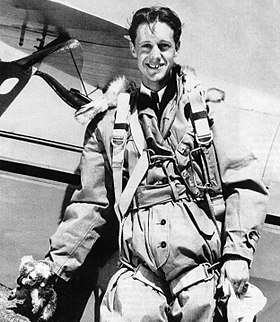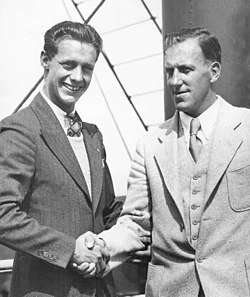Frank Kurtz
Colonel Frank Allen Kurtz, Jr.[2] (September 9, 1911 – October 31, 1996) was an American Olympic diver and an aviator in the United States Army Air Forces.
Frank Kurtz | |
|---|---|
 Frank Kurtz in 1935 | |
| Birth name | Frank Allen Kurtz, Jr. |
| Born | September 11, 1911 Davenport, Iowa, U.S.[1] |
| Died | October 31, 1996 (aged 85) North Hollywood, Los Angeles, U.S.[1] |
| Allegiance | |
| Service/ | United States Air Force |
| Rank | Colonel |
| Unit | |
| Awards |
|
| Spouse(s) | Margaret Rogers |
| Relations | Swoosie Kurtz (daughter) |
| Other work | Executive at William May Garland |
 Kurtz (left) and Swendsen in 1931 | |||||||||||
| Sport | |||||||||||
|---|---|---|---|---|---|---|---|---|---|---|---|
| Sport | Diving | ||||||||||
| Club | Los Angeles Athletic Club | ||||||||||
Medal record
| |||||||||||
Life and career
Kurtz was born in Davenport, Iowa, the third child of Dora Lee (née Fenton) and Frank Allen Kurtz, Sr., an insurance salesman.[3][4][5] He grew up in Kansas City, Missouri.[6] Kurtz became interested in flying at age 16, and in 1935 flew an open cockpit plane, setting a speed record flight from Los Angeles to Mexico City to Washington, D.C. and back to Los Angeles.
Kurtz's diving abilities impressed Olympic champion swimmer Johnny Weissmuller, who encouraged him to train with famous coach Clyde Swendsen.[6] Kurtz graduated from Hollywood High School and went on to the University of Southern California especially to join the diving team. He won a bronze medal in the 10 meter platform at the 1932 Olympics and placed fifth in 1936, competing with an injured shoulder.[6] He also won the AAU platform title in 1933.[1]
Military career
Kurtz joined the Army to train as a pilot, anticipating a career in commercial aviation. Before the war, he held the national junior transcontinental speed record and established half a dozen other speed marks for light planes.[7]
He was Commander of the 463d Bombardment Group (Heavy), 15th Air Force, Celone Airfield, Foggia, Italy (1944–45) and a survivor of the air attack at Clark Field in the Philippines, two days after the Japanese attack on Pearl Harbor on December 7, 1941. In Australia, he salvaged and helped to rebuild a B-17D Flying Fortress bomber using a combination of parts from other wrecked B-17s. At that time, the repaired B-17D was nicknamed "The Swoose" by 19th Bomb Group pilot, Captain Weldon Smith. The tail of a Boeing B-17D, AAF Ser. No. 40-3091 was grafted onto 40-3097, resulting in a hybrid B-17D. The bomber became "half swan and half goose" just like the lyrics in the then-popular novelty song "Alexander, The Swoose." Before the end of the war, "The Swoose" was scheduled to be scrapped and smelted down for its aluminium content. Kurtz then convinced the City of Los Angeles to retrieve his by-then famous bomber for use as a World War II memorial: It was the only B-17 that flew from the beginning of World War II until the end. Today, "The Swoose" is the oldest surviving B-17 and the only early "D" model still in existence. It is being restored at the National Museum of the United States Air Force at Wright-Patterson AFB in Fairborn, Ohio.
After 24 years in the service of the United States Armed Forces (U.S. Army Air Corps, U.S. Army Air Forces, and the U.S. Air Force), Kurtz retired and became a top executive at the William May Garland development firm.[8]
Personal life
Kurtz married Margret "Margo" Kurtz and had one child, actress Swoosie Kurtz (born 1944). His daughter's first name "Swoosie" (rhymes with Lucy, rather than woozy) is derived from his two B-17s named "The Swoose" and "Swoose II", which he piloted with the 19th and 463rd Bomb Groups.[1][8]
Kurtz died in 1996 from complications following a fall.[8] In 2012 he was inducted into the International Swimming Hall of Fame.[6]
See also
References
| Wikimedia Commons has media related to Frank Kurtz. |
- Frank Kurtz. sports-reference.com
- Armstrong, A.C.; Vitale, S.A.; Who's Who Historical Society (Calif.). Who's who in California. 12. Who's Who Historical Society. ISSN 0511-8948.
- Betz, P.R.; Carnes, M.C.; American Council of Learned Societies (2005). American National Biography: Supplement 2. Oxford University Press, USA. p. 328. ISBN 9780195222029.
- Fowler, C.C. (1950). The history of the Fowlers. C.C. Fowler.
- Armstrong, A.C.; Who's Who Historical Society (Calif.) (1976). Who's who in California. Who's Who Historical Society. ISSN 0511-8948.
- Colonel Frank Kurtz (USA) 2012 Honor Pioneer Diver. ishof.org
- Oliver, Myrna (November 7, 1996). "Frank Kurtz; World War II Aviation Hero".
- Frank Kurtz. lanbob.com